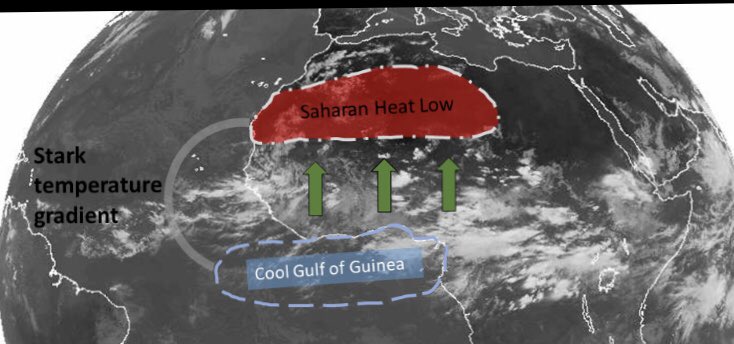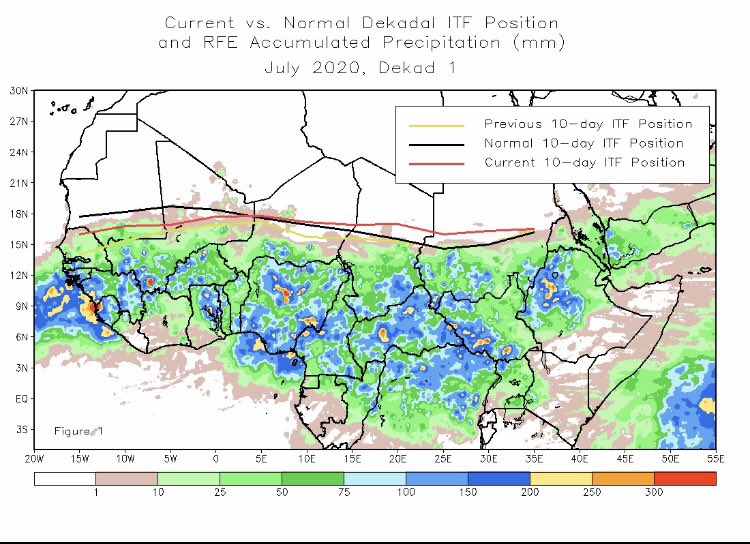Although we’re a bit late (again!) here is this week’s iterationof ‘Educational Tuesday!’ This weeks topic is the West African Monsoon (WAM). #WxTwitter #Weather #Tropics 1. The WAM (West African Monsoon) is one of the main teleconnections that drive an Atlantic Hurricane
Season and is responsible for most of the Main Development Region (MDR) Tropical cyclogenisis (TCG) events that occur during a specific season. It is the birthplace of the African Easterly Waves (AEWs) that become the seedlings for tropical cyclones in the Atlantic, Eastern
Pacific and Central Pacific. Most of the sub-saharan precipitation can also be attributed to its existence.
2. Similar to other oceanic monsoonal complexes, like the annual Indian Monsoon or the Southwest Monsoon near the Philippines, the majority of the WAM´s convection
2. Similar to other oceanic monsoonal complexes, like the annual Indian Monsoon or the Southwest Monsoon near the Philippines, the majority of the WAM´s convection
occurs due to the difference between the Saharan Heat Low (SHL) to the north and the comparitively cool Gulf of Guinea to the south.
What this means is that the Saharan Heat Low emitts high amounts of outgoing long-wavelength radiation (OLR) caused by the warm air over the
What this means is that the Saharan Heat Low emitts high amounts of outgoing long-wavelength radiation (OLR) caused by the warm air over the
Sahara rapidly cooling as it can rise freely without convection (clouds) hindering it. This cool air then tries to warm again so it flows to the nearest dominant heat source, here West Africa (since the ground there can still warm during the day).
Contrary to that, the
Contrary to that, the
relatively cool air over the Gulf of Guinea is flowing northeast caused by the normal trade flow in the Northern Hemisphere near the equator (due to the Coriolis Effect).
3. Convection occurs there where both flows meet since they sort-of “push“ each other upwards, forming a column of rising air, rich in both moisture (due to the nearby ocean + intertropical convergence zone). As the column reaches higher altitudes of our atmosphere (here up to
the tropopause) the warm air cools, thus not being able to hold as much moisture which leads to the formation of clouds as the air is oversaturated.
4. As is the case with other monsoons, the WAM also only occurs during a certain time of the year, generally between April to
4. As is the case with other monsoons, the WAM also only occurs during a certain time of the year, generally between April to
November but most notably between June and October. As the sun slowly rises until it reaches its zenith, the WAM increases in amplitude, also slowly moving north until it reaches it peak northerly extend (around ~20N) in late July-early August before it retrogades southward again
5. The African Easterly Jet (AEJ), found between the 700 and 600mb layer is also largely responsible for how dry/moist the WAM is during its peak months. A stronger AEJ (more southward since more zonally amplified) is very stable and allows less convection to move poleward
(north), thus drying the WAM region. The opposite occurs for a weaker, more meridionally instable AEJ.
6. The precipation found within the WAM is also strongly dependent on intraseasonal velocity potential anomalies, as caused by several large teleconnections (El Nino
6. The precipation found within the WAM is also strongly dependent on intraseasonal velocity potential anomalies, as caused by several large teleconnections (El Nino
Southern Oscillation, Indian Ocean Dipole), planetary waves (Madden-Julian Oscillation, Convectively-Coupled Kelvin Wave) or extratropical forcing (Rossby Wave trains). Some aspects of the planetary waves phenomenom were explained in a previous iteration of Educational Tuesday
already, so those are also essential for understanding the WAM as a general topic. In a nutshell, -VP200 anomalies enhance convection over Africa and specifically the WAM and destabilize the AEJ, allowing for convection to more easily move northward. +VP200 suppresses the WAM
and dries it out more than is the case on average.
7. As alluded to earlier, the WAM is part of the reason why African Easterly Waves even exist in the first place. While their birthplace is originally over the Ethiopian Highlands due to orographic lift causing more leeward
7. As alluded to earlier, the WAM is part of the reason why African Easterly Waves even exist in the first place. While their birthplace is originally over the Ethiopian Highlands due to orographic lift causing more leeward
relative vorticity, the WAM helps to further amplify their mid-level vorticity due to continous convection inducing vortex stretching onto the nascent waves. In essence, the WAM is feeding the AEWs enough vorticity so that they can survive the trek over the open Atlantic once
they exit Western Africa.
Do you have any suggestions for next weeks Educational Tuesday? Make sure to let us know! If you have any questions regarding this weeks Educational Tuesday, we would also be glad to answer your questions!
Do you have any suggestions for next weeks Educational Tuesday? Make sure to let us know! If you have any questions regarding this weeks Educational Tuesday, we would also be glad to answer your questions!

 Read on Twitter
Read on Twitter




